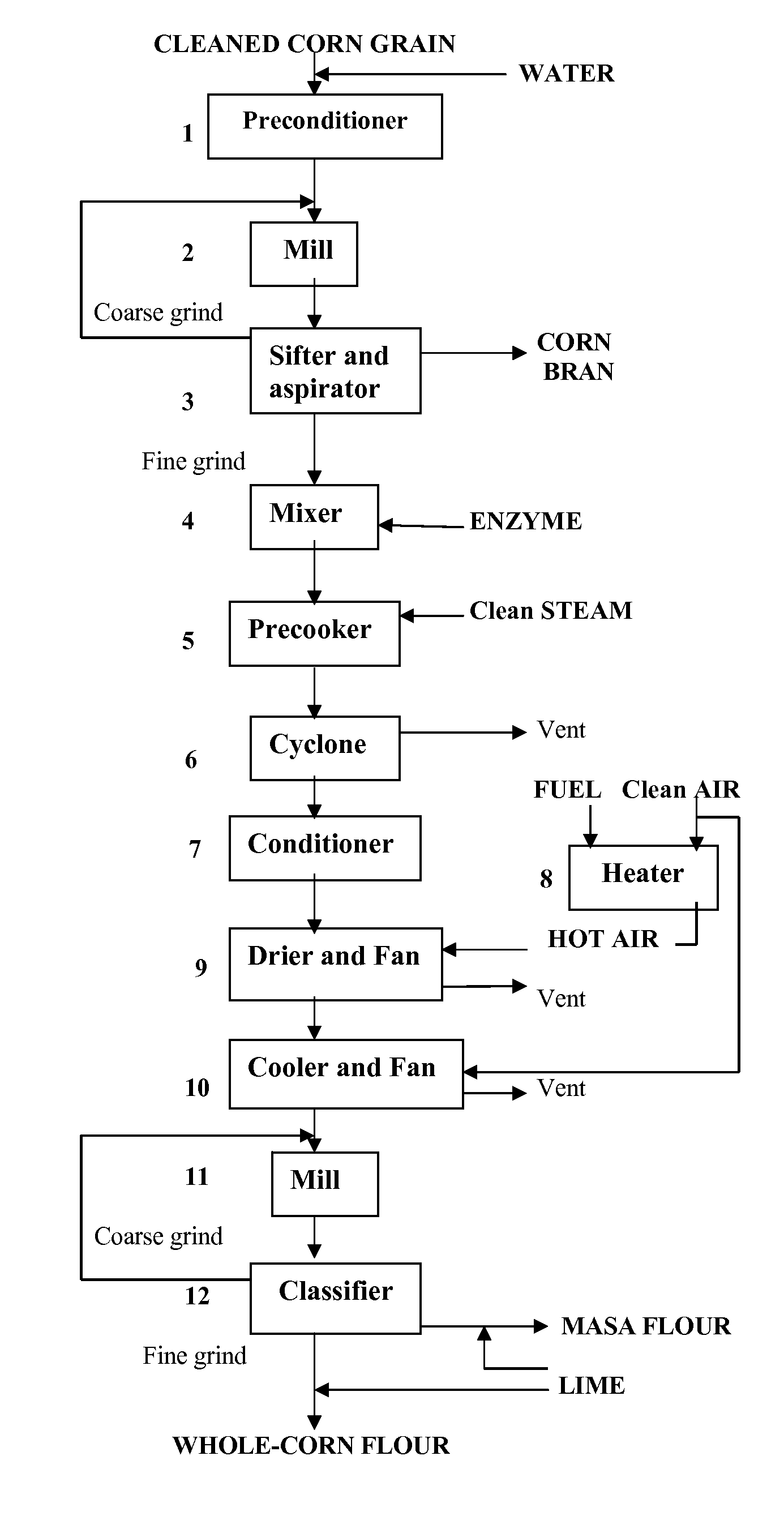Continuous production of cereal flour and whole-cereal flour for grain-based foods, using a low-moisture precooking
a technology which is applied in the field of continuous production of cereal flour and whole-cereal flour for grain-based foods, using a low-moisture precooking, can solve the problems of pericarp, loss and solubilization of part of bran and phenolics into alkaline wastewater,
- Summary
- Abstract
- Description
- Claims
- Application Information
AI Technical Summary
Benefits of technology
Problems solved by technology
Method used
Image
Examples
example 1
Preparation of corn-based foods using a pregel masa flour as a cereal-base ingredient:
[0069] The pregel masa and partial whole-flour made from the presented method can be rehydrated with warm water from a 1:0.9 to about 1:1.4 weight ratio for a high-yield masa dough (50% to 60% final moisture) used in the preparation of industrial corn-snacks and commercial tortilla-baked foods.
[0070] The masa flour contained on average about 9% of dietary fiber and a trans-ferulic content of 800 ppm (or expressed as 500 TE or μmol trolox-equivalent / 100 g), which was 50% lower than raw-corn flour (1600 ppm and 1000 TE). Ferulic was the predominant antioxidant and it was removed with the corn-bran along with niacin (40% decrease) during milling for a masa flour. It is possible that a 10%-40% loss of ferulic occurred during lye-hydrolysis (1-4h / 2N: Adom and Liu, 2002) and a higher 93% loss during lime-cooking (1 h cook, 15h steep with 0.75% w / v: Martinez-Bustos et al 2001).
[0071] This pregel parti...
example 2
[0076] Preparation of grain-based foods using an instant whole-corn flour as a cereal-base and functional-food ingredient:
[0077] The instant and whole-flour obtained from the aforementioned process can be uniformly mixed with 29% to 49% by weight grain flour in order to increase its ingredient formulation from about 70% to about 80% of dietary fiber and from 800% to about 1400% of phenolic antioxidants. The whole-flour can be rehydrated with warm water from a 1:0.6 to about 1:0.9 weight ratio for a low-yield corn dough (40% to 50% final moisture) used in the preparation of novel wheat-based and grain-based foods.
[0078] Furthermore, a whole-grain flour substitution (i.e., flat-bread) will provide an additional 0.98 to 1.36 fiber grams / serving and three flour-tortilla servings (52 grams or 1.9 oz whole-grain flour: USDA-SR16 for a whole-wheat bread with <38% moisture content) would supply about 12% to 16% of the FDA daily fiber value (cfsanfda.gov).
[0079] The Whole Grain Stamp was ...
PUM
 Login to View More
Login to View More Abstract
Description
Claims
Application Information
 Login to View More
Login to View More - R&D
- Intellectual Property
- Life Sciences
- Materials
- Tech Scout
- Unparalleled Data Quality
- Higher Quality Content
- 60% Fewer Hallucinations
Browse by: Latest US Patents, China's latest patents, Technical Efficacy Thesaurus, Application Domain, Technology Topic, Popular Technical Reports.
© 2025 PatSnap. All rights reserved.Legal|Privacy policy|Modern Slavery Act Transparency Statement|Sitemap|About US| Contact US: help@patsnap.com


